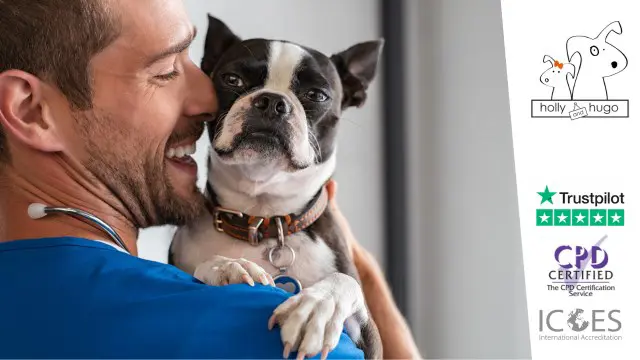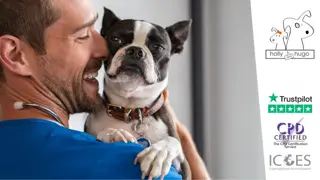
Veterinary Support Assistant (VET Assistant)
CPD UK & ICOES Accreditation | 30 CPD Points | Buy this course and avail of a FREE one-month membership to 200+ courses
Holly and Hugo
Summary
- Proof of Completion - Free
- Certificate of Achievement - £18.99
- ICOES Digital Certificate - £23.99
- ICOES Certificate - £29.99
- Continuing Professional Development (CPD) - £39.99
- Exam(s) / assessment(s) is included in price
Add to basket or enquire
Overview
Many people aspire to work with animals, but it can be difficult to distinguish the reality from the fluffy image. This course gives a firm grounding in reality, with essential skills such as animal handling and restraint, pet psychology and recognizing pain, and working as part of a veterinary team - as well as an understanding of technical terms, anatomy and physiology, and first aid.
The Veterinary Support Assistant
The Veterinary Support Assistant (VSA) is a highly capable member of the veterinary team, trained informally within the practice. A VSA is responsible for many crucial jobs within the clinic, such as ensuring good hygiene and sterility, handling animals, and interfacing with clients. Many VSAs use the opportunity to gain valuable experience and go on to qualify as Vet Technicians.
This course is of benefit to anyone with an interest in animal health, working with animals, or wondering if a career in the veterinary environment is right for them. It includes an overview of how veterinary practice works, health and safety, basic anatomy and physiology, animal handling techniques, first aid, and coping with emergency situations as well as emotional issues such as euthanasia.
Certificates
Proof of Completion
Digital certificate - Included
Certificate of Achievement
Digital certificate - £18.99
ICOES Digital Certificate
Digital certificate - £23.99
ICOES Certificate
Hard copy certificate - £29.99
Continuing Professional Development (CPD)
Digital certificate - £39.99
CPD
Course media
Description
Learn Core Skills Such As:
Anybody who comes into regular contact with animals be that in a kennel, rescue center, or a vet clinic, benefits from learning and understanding key aspects such as:
- Veterinary terminology
- Handling dogs, cats, small mammals, and exotics
- Animal psychology – interpreting signs of stress or pain
- Handling the fractious animal safely
- How to gently restrain animals for minor procedures
- The importance of disinfection and disease control
- Monitoring inpatients, such as taking vital signs and record keeping
- Basic animal anatomy and physiology
- Health and Safety regulations
- Feeding animals – both healthy and sick
The Role of a Veterinary Assistant within Veterinary Practice:
When you are in an unfamiliar environment, a veterinary practice can seem a busy, confusing, and intimidating place. The course equips you with information to help you find your feet quickly and make the most of the experience.
- The structure of veterinary practice
- Different roles within the veterinary team
- Confidentiality and professionalism
- How to learn on the job
- People skills such as dealing with anxious clients and booking appointments
- Understanding common procedures
- Be familiar with commonly used equipment
The Emotional Side
Pets are family members, and when faced with a hard decision in the best interests of their pet’s welfare, many owners become very emotional. The course helps you understand how to deal with this distress, what to expect when a pet is euthanized, and the practicalities involved afterwards.
Handling Emergencies
There may be occasions when you are faced with a pet in urgent need for emergency treatment. The course teaches you how to act whilst waiting for help to arrive
- Assessing the patient
- The principles of resuscitation
- Emergency stabilisation of haemorrhage, breathing difficulties, fractures etc.
- First aid
- Your role during an emergency
Working with animals is a hugely rewarding career. Whether you aspire to work in veterinary practice or at a shelter, or wish to investigate the commitment involved, this course gives a sound grounding in the core skills involved.
Veterinary Assistant Course Syllabu:
MODULE 1: Veterinary Practice and the Veterinary Support Assistant
- 1.1 The aims of this course
- 1.2 What is a Veterinary Support Assistant?
- 1.3 The structure of veterinary practice
- 1.4 Roles within the clinic team
- 1.5 Confidentiality and professionalism
MODULE 2: Developing Your Skill Set
- 2.1 The Practice Manual
- 2.2 Know your breeds
- 2.3 Listen and Learn
- 2.4 Understanding consent forms
- 2.5 Phone skills
- 2.6 Reception
- 2.7 Dealing with Anxious Clients
- 2.8 Using your Initiative
- 2.9 Personal appearance and manner
MODULE 3: Veterinary Terminology
- 3.1 Commonly used terms
- 3.2 Common procedures
- 3.3 Abbreviations
- 3.4 Equipment within the practice
MODULE 4: Basic Animal Handling
- 4.1 The principles of handling animals
- 4.2 Handling dogs
- 4.3 Handling cats
- 4.4 Handling small mammals
- 4.5 Handling exotics
MODULE 5: Animal Psychology
- 5.1 How animals react to stress
- 5.2 Reading body language
- 5.3 Minimizing stress
- 5.4 Recognizing pain in animals
MODULE 6: Advanced Animal Handling
- 6.1 Tools for handling the fractious animal
- 6.2 Restraining the fractious animal
- 6.3 Holding an animal for a medical examination
- 6.4 Holding an animal for a minor procedure
- 6.5 Holding an animal for a blood draw
MODULE 7: Around the Veterinary Practice
- 7.1 Theater protocol
- 7.2 Consultation protocol
- 7.3 Pre-operative preparations
- 7.4 Sterilizing instruments
- 7.5 Disinfection and disease control
MODULE 8: Care of In Patients
- 8.1 Monitoring animals and updating charts
- 8.2 TLC –Providing the optimum environment
- 8.3 Special measures (hand feeding and critical care)
- 8.4 Taking vital signs
MODULE 9: Feeding Animals
- 9.1 Feeding the well animal
- 9.2 Food and surgery
- 9.3 Life stage nutrition
- 9.4 Prescription diets
- 9.5 Feeding the sick animal
MODULE 10: Basic Anatomy
- 10.1 Anatomical terms
- 10.2 How animals differ from people
MODULE 11: Basic Physiology
- 11.1 Physiological terms
- 11.2 Normal reference ranges
MODULE 12: Euthanasia
- 12.1 Making a difficult decision
- 12.2 End of life choices
- 12.3 Euthanasia etiquette
- 12.4 How euthanasia is performed
- 12.5 Burial or cremation
MODULE 13: Emergencies
- 13.1 Dealing with an emergency
- 13.2 Your role during an emergency
- 13.3 Basic principles of resuscitation
MODULE 14: First Aid
- 14.1 Basic first aid
- 14.2 Bleeding
- 14.3 Shock
- 14.4 Breathing difficulties
- 14.5 Fractures
MODULE 15: Health & Safety, and Regulations
- 15.1 Risks within the veterinary environment
- 15.2 The importance of hygiene
- 15.3 Ionizing radiation regulations
- 15.4 Prescribing regulations
- 15.5 Disposal of clinical waste
About Holly and Hugo:
All our courses are accredited by the International Council for Online Educational Standards (ICOES). Courses are written strictly by veterinarians and experts in the field.
Our courses are available 24/7 from a PC, laptop/tablet or mobile device. You are supported by our friendly customer service team via email, phone, and our 24/7 Help Center.
Who is this course for?
This course is of benefit to anyone with an interest in animal health, working with animals, or wondering if a career in the veterinary environment is right for them.
It includes an overview of how veterinary practice works, health and safety, basic anatomy and physiology, animal handling techniques, first aid, and coping with emergency situations as well as emotional issues such as euthanasia.
All courses are accredited by the International Council for Online Educational Standards (ICOES). After passing any exams and completing a course successfully, students can opt to purchase an ICOES certificate from the third-party institution.
Holly and Hugo is also CPD certified, meaning the courses meet or exceed Continuing Professional Development standards and benchmarks.
Requirements
Holly and Hugo courses are designed for anyone with an interest in learning. No formal qualifications are required. Our courses are suitable if you want to learn new skills, start a new career, or if you’re already working in a particular industry and wish to upgrade your talents and enhance your resume.
Career path
- Veterinary Assistant - £13,805 - £18,429 per annum
- Receptionist for Veterinary Practice - £17,000 - £18,500 per annum
- Veterinary Nurse - £25,000 per annum
Questions and answers
ToU: “Course must be activated within 12 months of registration on our website. Each course is valid for 45 days from the date of course activation.”
Answer:Hey Cheyenne, That is typically true for our courses. However, through this amazing deal you will have Lifetime access – No time limits – Be able to study at your own pace.
This was helpful.I can work with nurse veterinary after i lern this course?
Answer:Upon course completion, you could become an assistant to a veterinary nurse. There are indeed many ways that your career could develop. You can pursue a degree as a Vet Tech or Vet Nurse, work in a rescue and adoption center, work in animal training or in kennels. Armed with your certificate of completion you’ll be able to demonstrate a high level of knowledge in the care of animals, which will help you stand out to any future employer.
This was helpful.What is the minimum age on this course please
Answer:Thank you for your query. There is no age-restriction to avail to our courses.
This was helpful.
Reviews
Legal information
This course is advertised on Reed.co.uk by the Course Provider, whose terms and conditions apply. Purchases are made directly from the Course Provider, and as such, content and materials are supplied by the Course Provider directly. Reed is acting as agent and not reseller in relation to this course. Reed's only responsibility is to facilitate your payment for the course. It is your responsibility to review and agree to the Course Provider's terms and conditions and satisfy yourself as to the suitability of the course you intend to purchase. Reed will not have any responsibility for the content of the course and/or associated materials.




